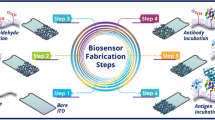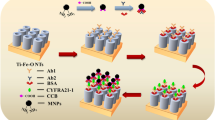Abstract
A highly sensitive enzymatic biosensor is successfully experimented for detection of abiraterone in human serum with significance in personalized medicine and point-of-care chemotherapy of patients with metastatic prostate cancer. The dynamic range and limit of the detection of the proposed biosensor coincide with the therapeutic range of abiraterone in circulatory system of patients (below 1 μM). An optimized label-free electrochemical biosensor was exploited in order to improve the performance of biosensor to detect low concentrations of abiraterone in human serum. Electroactive surface area has been increased by 4314 mm2 by multiwalled carbon nanotubes (MWCNTs) nanostructuring with respect to bare electrode to enhance the sensitivity. CYP3A4 protein was immobilized on MWCNTs as probe biomolecule. Electrochemical cyclic voltammetries demonstrated an inhibition effect on the CYP3A4, clearly observed as a diminished electrocatalytic activity of the enzyme. Dose-response behavior of biosensor in interaction with abiraterone in human serum samples is demonstrated that shows a dynamic range between zero and 1 μM and a detection limit of 230 nM.



Similar content being viewed by others
References
Malvezzi, M., Carioli, G., Bertuccio, P., Rosso, T., Boffetta, P., Levi, F., Vecchia, C. L., & Negri, E. (2016). European cancer mortality predictions for the year 2016 with focus on leukemias. Annals of Oncology. doi: 10.1093/annonc/mdw022.
Hakki, T., & Bernhardt, R. (2006). CYP17- and CYP11B-dependent steroid hydroxylases as drug development targets. Pharmacology & Therapeutics, 111, 27–52. doi:10.1016/j.pharmthera.2005.07.006.
Zanger, U. M., & Schwab, M. (2013). Cytochrome P450 enzymes in drug metabolism: regulation of gene expression, enzyme activities, and impact of genetic variation. Pharmacology & Therapeutics, 138, 103–141. doi:10.1016/j.pharmthera.2012.12.007.
Acharya, M., Bernard, A., Gonzalez, M., Jiao, J., Vries, R. D., & Tran, N. (2012). Open-label, phase I, pharmacokinetic studies of abiraterone acetate in healthy men. Cancer Chemotherapy and Pharmacology, 69, 1583–1590. doi:10.1007/s00280-012-1865-3.
Evans, W. E., & Relling, M. V. (2004). Moving towards individualized medicine with pharmacogenomics. Nature, 429, 464–468. doi:10.1038/nature02626.
Weinshilboum, R., & Wang, L. (2004). Pharmacogenomics: bench to bed-side. Nature Reviews. Drug Discovery, 3, 739–748. doi:10.1038/nrd1497.
Aliakbarinodehi, N., Taurino, I., Pravin, J., Tagliaferro, A., Piccinini, G., De, M. G., & Carrara, S. (2014). Electrochemical nanostructured biosensors: carbon nanotubes versus conductive and semi-conductive nanoparticles. Chemical Papers, 69, 134–142. doi:10.1515/chempap-2015-0004.
Aliakbarinodehi, N., Micheli, G.D., Carrara, S. (2015) Optimized electro-chemical detection of anti-cancer drug by carbon nanotubes or gold nanoparticles. In: Res. Microelectron. Electron. PRIME 2015 11th Conf. PhD. pp 25–28.
Aliakbarinodehi, N., De Micheli, G., & Carrara, S. (2016). Enzymatic and nonenzymatic electrochemical interaction of abiraterone (antiprostate cancer drug) with multiwalled carbon nanotube bioelectrodes. Analytical Chemistry, 88, 9347–9350. doi:10.1021/acs.analchem.6b02747.
Asturias-Arribas, L., Alonso-Lomillo, M. A., Domínguez-Renedo, O., & Arcos-Martínez, M. J. (2013). Electrochemical determination of cocaine using screen-printed cytochrome P450 2B4 based biosensors. Talanta, 105, 131–134. doi:10.1016/j.talanta.2012.11.078.
Carrara, S., Cavallini, A., Erokhin, V., & De Micheli, G. (2011). Multi-panel drugs detection in human serum for personalized therapy. Biosens Bio-electron, 26, 3914–3919. doi:10.1016/j.bios.2011.03.009.
Baj-Rossi, C., Rezzonico Jost, T., Cavallini, A., Grassi, F., De Micheli, G., & Carrara, S. (2014). Continuous monitoring of naproxen by a cytochrome P450-based electrochemical sensor. Biosensors & Bioelectronics, 53, 283–287. doi:10.1016/j.bios.2013.09.058.
Baj-Rossi, C., Micheli, G. D., & Carrara, S. (2012). Electrochemical detection of anti-breast-cancer agents in human serum by cytochrome P450-coated carbon nanotubes. Sensors, 12, 6520–6537. doi:10.3390/s120506520.
Sun, P., & Wu, Y. (2013). An amperometric biosensor based on human cytochrome P450 2C9 in polyacrylamide hydrogel films for bisphenol A determination. Sens Actuators B Chem, 178, 113–118. doi:10.1016/j.snb.2012.12.055.
Wu, Y., Liu, X., Zhang, L., & Wang, C. (2011). An amperometric biosensor based on rat cytochrome p450 1A1 for benzo[a]pyrene determination. Biosensors & Bioelectronics, 26, 2177–2182. doi:10.1016/j.bios.2010.09.027.
Müller M, Agarwal N, Kim J (2016) A cytochrome P450 3A4 biosensor based on generation 4.0 PAMAM dendrimers for the detection of caffeine. Biosensors 6:44. doi: 10.3390/bios6030044
Asturias-Arribas, L., Alonso-Lomillo, M. A., Domínguez-Renedo, O., & Arcos-Martínez, M. J. (2011). CYP450 biosensors based on screen-printed car-bon electrodes for the determination of cocaine. Analytica Chimica Acta, 685, 15–20. doi:10.1016/j.aca.2010.11.006.
Armbruster, D. A., & Pry, T. (2008). Limit of blank, limit of detection and limit of quantitation. Clinical Biochemist Reviews, 29, S49–S52.
Acknowledgements
This research was partly funded by the European Commission FP7 Program through the Marie Curie Initial Training Network PROSENSE (grant no. 317420, 2012-2016) and partly by H2020-ERC-2014-ADG 669354 CyberCare.
Author Contributions
The manuscript was written through the contributions of all authors. All authors have given approval to the final version of the manuscript.
Author information
Authors and Affiliations
Corresponding author
Ethics declarations
Conflict of Interest
The authors declare that they have no conflict of interest.
Rights and permissions
About this article
Cite this article
Aliakbarinodehi, N., De Micheli, G. & Carrara, S. Highly Sensitive Enzymatic MWCNTs-Based Biosensors for Detection of Abiraterone in Human Serum. BioNanoSci. 8, 675–679 (2018). https://doi.org/10.1007/s12668-017-0393-3
Published:
Issue Date:
DOI: https://doi.org/10.1007/s12668-017-0393-3




